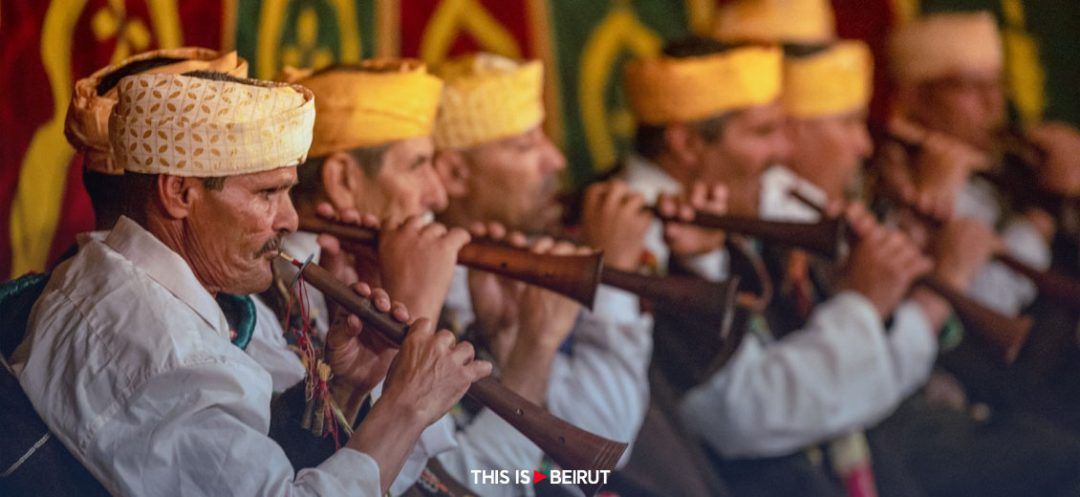
©Photo by Fadel Senna/AFP
In a small Moroccan village, ancient melodies intertwine with hypnotic rhythms, drawing devotees from around the world to experience the timeless magic of Joujouka music.
The Master Musicians of Joujouka, a collective that has captivated audiences at prestigious venues worldwide, return to their mountain village every spring to perform for an intimate gathering of around 50 devotees. This tribal trance festival, once dubbed by Rolling Stone magazine as “the oldest, most exclusive dance party in the world,” celebrates centuries of local tradition and Sufi-inspired tunes.
[gallery size="full" link="none" ids="260574,260573,260572"]
According to legend, the music’s influences trace back 4,000 years in the Rif Mountains region. It also draws on Sufism, the mystical branch of Islam, whose saint Sidi Ahmed Cheikh arrived in the village during the 15th century. Ahmed El Attar, the 67-year-old leader of the collective, believes that the saint’s blessing helped their music gain global recognition.
The festival takes place in a large tent adorned with carpets, set up in an olive tree-lined courtyard. As the clock strikes midnight, 15 musicians dressed in wool djellabas begin to play, filling the night with the piercing sound of ghaita horns. The session continues for nearly three hours without breaking tempo, showcasing the incredible power and synchronicity of the group.
One of the highlights of the festival is the appearance of Boujloud, a mythical half-man, half-goat figure. Three boys dressed in traditional women’s clothes signal the creature’s arrival, and as the lights go out, Boujloud emerges before the flames of a blazing fire, dancing and waving branches to bestow blessings and fertility upon the gathered devotees.
The Joujouka group’s rise to international fame owes much to the efforts of Moroccan artist Mohamed Hamri, who brought the music to the attention of foreign artists in the 1950s. Among the early fans were Beat Generation legends Brion Gysin and William Burroughs. However, it was Rolling Stones founder Brian Jones who played a pivotal role in popularizing the music. In 1968, Jones traveled to Morocco and recorded the Joujouka musicians for an album released posthumously in 1971, titled “Brian Jones Presents the Pipes of Pan at Joujouka.”
The growing fame allowed the Moroccan artists to travel the world, but disagreements led to a split in the early 1990s, resulting in the formation of a separate group called the Master Musicians of Jajouka, led by Bachir Attar.
According to Abdessalam Rrtoubi, a 64-year-old ghaita player, the music’s power to “heal souls” is endowed by the group’s patron Sufi saint, who is buried in the village. Many devotees, like Japanese musician Haitaro Hanamura, return year after year not only for the music, but also for its therapeutic properties.
The festival’s organizer, Frank Rynne, believes that the music “keeps something alive that people can identify with as an ancient spiritual connection.” Due to high demand, the event is now held over two dates, allowing more people to experience the timeless magic of Joujouka music in the heart of the Moroccan mountains.
As the hypnotic drum beats and ancient melodies continue to resonate through the village, the Master Musicians of Joujouka preserve a precious piece of cultural heritage, ensuring that the music never stops echoing through the generations.
With AFP
The Master Musicians of Joujouka, a collective that has captivated audiences at prestigious venues worldwide, return to their mountain village every spring to perform for an intimate gathering of around 50 devotees. This tribal trance festival, once dubbed by Rolling Stone magazine as “the oldest, most exclusive dance party in the world,” celebrates centuries of local tradition and Sufi-inspired tunes.
[gallery size="full" link="none" ids="260574,260573,260572"]
According to legend, the music’s influences trace back 4,000 years in the Rif Mountains region. It also draws on Sufism, the mystical branch of Islam, whose saint Sidi Ahmed Cheikh arrived in the village during the 15th century. Ahmed El Attar, the 67-year-old leader of the collective, believes that the saint’s blessing helped their music gain global recognition.
The festival takes place in a large tent adorned with carpets, set up in an olive tree-lined courtyard. As the clock strikes midnight, 15 musicians dressed in wool djellabas begin to play, filling the night with the piercing sound of ghaita horns. The session continues for nearly three hours without breaking tempo, showcasing the incredible power and synchronicity of the group.
One of the highlights of the festival is the appearance of Boujloud, a mythical half-man, half-goat figure. Three boys dressed in traditional women’s clothes signal the creature’s arrival, and as the lights go out, Boujloud emerges before the flames of a blazing fire, dancing and waving branches to bestow blessings and fertility upon the gathered devotees.
The Joujouka group’s rise to international fame owes much to the efforts of Moroccan artist Mohamed Hamri, who brought the music to the attention of foreign artists in the 1950s. Among the early fans were Beat Generation legends Brion Gysin and William Burroughs. However, it was Rolling Stones founder Brian Jones who played a pivotal role in popularizing the music. In 1968, Jones traveled to Morocco and recorded the Joujouka musicians for an album released posthumously in 1971, titled “Brian Jones Presents the Pipes of Pan at Joujouka.”
The growing fame allowed the Moroccan artists to travel the world, but disagreements led to a split in the early 1990s, resulting in the formation of a separate group called the Master Musicians of Jajouka, led by Bachir Attar.
According to Abdessalam Rrtoubi, a 64-year-old ghaita player, the music’s power to “heal souls” is endowed by the group’s patron Sufi saint, who is buried in the village. Many devotees, like Japanese musician Haitaro Hanamura, return year after year not only for the music, but also for its therapeutic properties.
The festival’s organizer, Frank Rynne, believes that the music “keeps something alive that people can identify with as an ancient spiritual connection.” Due to high demand, the event is now held over two dates, allowing more people to experience the timeless magic of Joujouka music in the heart of the Moroccan mountains.
As the hypnotic drum beats and ancient melodies continue to resonate through the village, the Master Musicians of Joujouka preserve a precious piece of cultural heritage, ensuring that the music never stops echoing through the generations.
With AFP
Read more



Comments